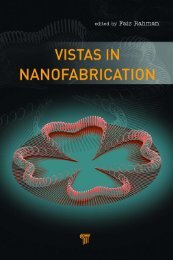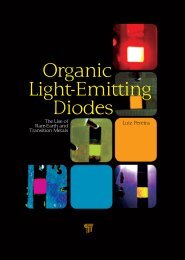Download PDF - Pan Stanford Publishing
Download PDF - Pan Stanford Publishing
Download PDF - Pan Stanford Publishing
You also want an ePaper? Increase the reach of your titles
YUMPU automatically turns print PDFs into web optimized ePapers that Google loves.
viii<br />
Contents<br />
4.2.1 Electronic Absorption Spectrum 180<br />
4.2.2 Vibrational Contributions 182<br />
4.3 Photophysics 184<br />
4.3.1 Semiclassical Description of Internal<br />
Conversion and Inter-System Crossing 187<br />
4.4 Computational Methods for Excited States 190<br />
4.4.1 Configuration Interaction 194<br />
4.4.2 Time-Dependent Density Functional<br />
Theory 196<br />
4.4.3 Linear Response TD-DFT 200<br />
5 Metal–Molecule Electrodynamic Coupling 213<br />
S. Corni<br />
5.1 Introduction 213<br />
5.2 The Quasi-Static Limit 217<br />
5.3 The Point-Dipole Model of the Molecule, and the<br />
Classical Metal Nanoparticle 219<br />
5.3.1 Light Absorption 220<br />
5.3.2 Light Emission 225<br />
5.3.3 Light Scattering 234<br />
5.3.4 The Dielectric Function of the Classical Metal<br />
Nanoparticle 237<br />
5.4 Toward an ab initio Molecular Plasmonics 243<br />
5.4.1 Coupling the ab-initio Description of the<br />
Molecule with a Continuous Metal 243<br />
5.4.2 Fully ab initio Description of the<br />
Molecule–Metal Nanoparticle Systems 246<br />
PART II<br />
APPLICATIONS AND EXPERIMENTAL ASPECTS<br />
6 Near-Fields in Assembled Plasmonic Nanostructures 261<br />
P. K. Jain and C. Deeb<br />
6.1 Introduction 262<br />
6.2 Optical Properties of Metal Nanoparticles 262<br />
6.2.1 Nanoplasmonic Field Enhancement 265<br />
6.2.2 Tunability of the LSPR and Near-Field 266<br />
6.3 Optical Properties of Coupled Nanoparticles 268<br />
6.3.1 Nanoparticle Assemblies 268
















